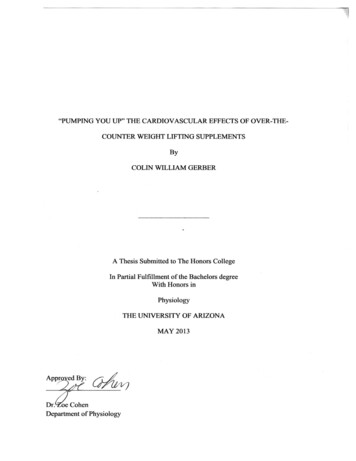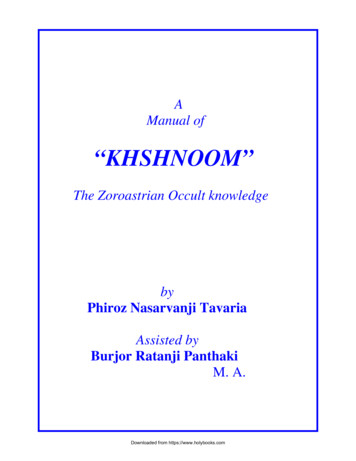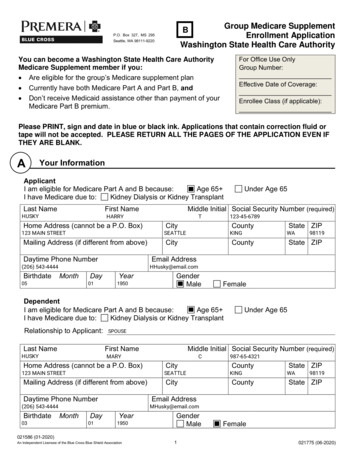
Transcription
T HE N ETWO RKIN G &INFO RMATION T ECHNO LO G YRESEARCH & DEVELOPMENT PROGRAMSUPPLEMENT TO THEPRESIDENT’S FY2019 BUDGETProduct of theSUBCOMMITTEE ON NETWORKING & INFORMATION TECHNOLOGYRESEARCH & DEVELOPMENTCOMMITTEE ON SCIENCE & TECHNOLOGY ENTERPRISEof theNATIONAL SCIENCE & TECHNOLOGY COUNCILAUGUST 2018
About This DocumentThis document is a supplement to the President’s FY2019 Budget Request to Congress. It describes activities planned for FY2019by the Federal agencies participating in the Networking and Information Technology Research and Development (NITRD)Program. It reports actual investments for FY2017, estimated investments for FY2018, and requested funding levels for FY2019by agency and Program Component Area (PCA). For the FY2019 budget request, this Supplement identifies the strategic priorities,key programs, and key coordination activities of each NITRD PCA. An appendix to the Supplement, FY2019 Federal CybersecurityR&D Strategic Plan Implementation Roadmap, lists existing and proposed Federal R&D projects and programs that address theNation’s critical cybersecurity challenges; it is available at dmap.pdf.About the National Science and Technology CouncilThe NITRD Program is managed by the NITRD Subcommittee of the National Science and Technology Council (NSTC)Committee on Science and Technology Enterprise. The NSTC is the principal means by which the Executive Branchcoordinates science and technology policy across the diverse entities that make up the Federal research and developmententerprise. A primary objective of the NSTC is to ensure science and technology policy decisions and programs are consistentwith the President’s stated goals. The NSTC prepares research and development strategies that are coordinated acrossFederal agencies aimed at accomplishing multiple national goals. The work of the NSTC is organized under committees thatoversee subcommittees and working groups focused on different aspects of science and technology. More information isavailable at https://www.whitehouse.gov/ostp/nstc.About the Office of Science and Technology PolicyThe Office of Science and Technology Policy (OSTP) was established by the National Science and Technology Policy,Organization, and Priorities Act of 1976 to provide the President and others within the Executive Office of the President withadvice on the scientific, engineering, and technological aspects of the economy, national security, homeland security, health,foreign relations, the environment, and the technological recovery and use of resources, among other topics. OSTP leadsinteragency science and technology policy coordination efforts, assists the Office of Management and Budget with an annualreview and analysis of Federal research and development in budgets, and serves as a source of scientific and technologicalanalysis and judgment for the President with respect to major policies, plans, and programs of the Federal Government. Moreinformation is available at https://www.whitehouse.gov/ostp.About the NITRD ProgramThe Networking and Information Technology Research and Development Program is the Nation’s primary source of federallyfunded research and development (R&D) on networking and information technology (IT). The NITRD Program seeks tomaximize interagency coordination in providing the R&D foundations for continued U.S. technological leadership andmeeting the needs of the Federal Government for advanced IT. The Program also seeks to accelerate development anddeployment of advanced IT to support American military superiority, security, economic prosperity, energy dominance, andhealth, while it supports innovation and early-stage research, modernization of the IT research infrastructure, anddevelopment of a strong cyber-enabled workforce. The NITRD Program—established by the High-Performance Computing Actof 1991 (P.L. 102-194) and reauthorized by Congress in the American Innovation and Competitiveness Act of 2017 (P.L. 114329)—is one of the oldest and largest of the formal Federal programs that engage multiple agencies in coordination activities.More information is available at https://www.nitrd.gov.About the NITRD National Coordination OfficeThe National Coordination Office (NCO) supports the NITRD Program, the NITRD Subcommittee, and its Interagency WorkingGroups (IWGs) by providing technical expertise, planning, and coordination, and by serving as the Program's central point ofcontact. The NCO continuously seeks to enhance its ability to be a catalyst for collaboration, exchange of information, andoutreach to foster knowledge, methods, R&D, technology transfer, and innovation for U.S. global leadership in networkingand information technology and its applications. In cooperation with NITRD agencies and IWGs, the NCO prepares anddisseminates the annual NITRD Supplement to the President’s Budget. More information is available wledgmentsThis Supplement to the President’s Budget was developed through the contributions of the NITRD Federal agencyrepresentatives and members, the NCO staff, and other Federal agencies participating in the NITRD Program.Copyright InformationThis document is a work of the United States Government and is in the public domain (see 17 U.S.C. §105). Subject to thestipulations below, it may be distributed and copied with acknowledgment to OSTP. Requests to use any images must be madeto OSTP. This and other NITRD documents are available at https://nitrd.gov/pubs. Published in the United States of America, 2018.iiNITRD Supplement to the President’s FY2019 Budget
National Science and Technology CouncilChair, Ted Wackler, Deputy Chief of StaffStaff: Chloe Kontos, Executiveand Assistant Director, OSTPDirector, NSTCCommittee on Science and Technology EnterpriseSubcommittee on Networking and Information Technology Research and DevelopmentCo-Chair, Kathleen (Kamie) Roberts (NCO)Co-Chair, Erwin Gianchandani (NSF)Executive Secretary, Nekeia Butler (NCO)National Coordination Officefor Networking and Information Technology Research and DevelopmentDirector, Kathleen (Kamie) RobertsNITRD Subcommittee MembersDepartment of Commerce (DOC)Department of Energy (DOE)National Oceanic and AtmosphericAdministration (NOAA)RepresentativeFrank IndiviglioAlternateLeslie HartOffice of Electricity Delivery andEnergy Reliability (DOE/OE)RepresentativeCarol HawkNational Institute of Standards andTechnology (NIST)RepresentativeCharles H. RomineAlternateElham TabassiDepartment of Defense (DoD)National Nuclear SecurityAdministration (DOE/NNSA)RepresentativeMark AndersonAlternateThuc T. HoangDefense Advanced Research ProjectsAgency (DARPA)RepresentativeBrian PierceMilitary ServicesAir ForceRepresentativeAnthony M. NewtonArmyRepresentativeThomas RussellAlternateNora PasionNavyRepresentativeJoan S. ClevelandAlternateSukarno MertogunoNational Security Agency (NSA)RepresentativeGeorge CokerOffice of the Secretary of Defense(OSD)RepresentativeRichard LindermanAlternateDai H. KimOffice of Science (DOE/SC)RepresentativeBarbara HellandAlternateCeren Susut-BennettDepartment of Health andHuman Services (HHS)Agency for Healthcare Researchand Quality (AHRQ)RepresentativeChristine DymekAlternateChun-Ju (Janey) HsiaoNational Institutes of Health (NIH)RepresentativeSusan GregurickAlternatePeter LysterOffice of the National Coordinator forHealth Information Technology (ONC)RepresentativeTeresa Zayas CabánAlternateKevin ChaneyDepartment of Justice (DOJ)National Institute of Justice (NIJ)RepresentativeWilliam FordAlternateMark GreeneIndependent AgenciesEnvironmental Protection Agency(EPA)RepresentativeGary L. WalterNational Aeronautics and SpaceAdministration (NASA)RepresentativeTerry JacksonNational Archives and RecordsAdministration (NARA)RepresentativeMark ConradNational Reconnaissance Office (NRO)RepresentativeThomas JenkinsNational Science Foundation (NSF)RepresentativeErwin GianchandaniExecutive Office of the PresidentOffice of Management and Budget(OMB)RepresentativeTali Bar-ShalomOffice of Science and TechnologyPolicy (OSTP)RepresentativeLloyd J. WhitmanDepartment of HomelandSecurity (DHS)RepresentativeDouglas MaughanAlternateScott W. TousleyNITRD Supplement to the President’s FY2019 Budgetiii
Other Participating Departments and AgenciesThese Federal departments and agencies participate in NITRD activities and have mission interests in advancednetworking and IT R&D and applications; they support NITRD Program coordination but do not participate in theNITRD Subcommittee.Department of Agriculture (USDA)Agricultural Research Service (ARS)National Institute of Food and Agriculture (NIFA)Department of Commerce (DOC)International Trade Administration (ITA)National Telecommunications and InformationAdministration (NTIA)United States Census Bureau (Census)Department of Defense (DoD)Defense Information Systems Agency (DISA)DoD Intelligence Information Systems (DoDIIS)National Geospatial-Intelligence Agency (NGA)Special Operations Command (SOCOM)United States Marine Corps (USMC)Department of Education (ED)Department of Energy (DOE)Office of Cybersecurity, Energy Security, and EmergencyResponse (DOE/CESER)Office of Energy Efficiency and Renewable Energy(DOE/EERE)Office of Environmental Management (DOE/EM)Department of Health and Human Services (HHS)Centers for Disease Control and Prevention (CDC)Food and Drug Administration (FDA)Health Resources and Services Administration (HRSA)National Institute for Occupational Safety and Health(NIOSH)National Institute on Disability, Independent Living,and Rehabilitation Research (NIDILRR)Department of Housing and Urban Development (HUD)ivDepartment of the Interior (Interior)U.S. Geological Survey (USGS)Department of Justice (DOJ)Federal Bureau of Investigation (FBI)Drug Enforcement Administration (DEA)Department of Labor (DOL)Bureau of Labor Statistics (BLS)Occupational Safety and Health Administration (OSHA)Department of State (DOS)Department of Transportation (DOT)Federal Aviation Administration (FAA)Federal Highway Administration (FHWA)Intelligent Transportation Systems Joint ProgramOffice (ITS JPO)Department of the Treasury (Treasury)Department of Veterans Affairs (VA)Federal Communications Commission (FCC)Federal Deposit Insurance Corporation (FDIC)Federal Trade Commission (FTC)General Services Administration (GSA)Nuclear Regulatory Commission (NRC)Office of the Director of National Intelligence (ODNI)Intelligence Advanced Research Projects Activity (IARPA)National Counterintelligence and Security Center (NCSC)National Counterterrorism Center (NCTC)United States Agency for International Development(USAID)United States Office of Personnel Management (OPM)United States Postal Service (USPS)NITRD Supplement to the President’s FY2019 Budget
Table of ContentsNITRD Subcommittee Members . iiiOther Participating Departments and Agencies . iv1. Introduction and Overview . 1Advancing National R&D Priorities . 1Budget Reporting Structure . 2Program Component Areas. 2Interagency Working Groups. 3Structure of this Supplement. 42. NITRD Budgets by Agency and PCA, FYs 2017–2019. 5Overview . 5Budget Charts . 5Table 1. Agency NITRD Budgets by PCA, FYs 2017–2019 . 6Budget Analysis by Agency . 73. Program Component Areas . 9Computing-Enabled Human Interaction, Communication, and Augmentation (CHuman) PCA . 9Computing-Enabled Networked Physical Systems (CNPS) PCA. 11Cyber Security and Privacy (CSP) PCA . 15Education and Workforce (EdW) PCA . 19Enabling R&D for High-Capability Computing Systems (EHCS) PCA . 21High-Capability Computing Infrastructure and Applications (HCIA) PCA. 23Intelligent Robotics and Autonomous Systems (IRAS) PCA . 25Large Scale Data Management and Analysis (LSDMA) PCA . 27Large Scale Networking (LSN) PCA . 29Software Productivity, Sustainability, and Quality (SPSQ) PCA . 334. Additional NITRD Interagency Coordination Activities . 35Faster Administration of Science and Technology Education and Research (FASTER)Community of Practice. 35Health Information Technology Research and Development (HITRD) IWG . 35Video and Image Analytics (VIA) IWG . 36Appendix A. List of Abbreviations . 37NITRD Supplement to the President’s FY2019 Budgetv
viNITRD Supplement to the President’s FY2019 Budget
1. Introduction and OverviewInformation technology (IT) is perhaps the most broadly transformative technology ever invented,with impacts on defense, security, energy, healthcare, and more. Innovation in IT continually enablespivotal new applications that advance U.S. national priorities and Federal agency missions. For 27years, the Networking and Information Technology Research and Development (NITRD) Program hasbeen the Nation’s primary source of federally funded research and development (R&D) on networkingand information technology. The Program maximizes coordination of Federal IT R&D to optimizeFederal investments that support agency missions and contribute to the public good.The NITRD Program is tasked with providing the IT R&D foundations for assuring continued U.S.leadership in science and technology, supporting investments that develop tools and technologieswith the potential to open new areas of discovery, and increasing government accountability andefficiency with advanced IT. The NITRD Program provides a framework and mechanisms to maximizecoordination among the many Federal agencies that support R&D in advanced informationtechnologies and report IT research budgets in this NITRD Supplement to the President’s fiscal year(FY) 2019 Budget. As required by legislation, this NITRD Supplement details the NITRD Program’sFY2019 requested budgets by participating agency and Program Component Area (PCA) to meetProgram goals and national priorities for state-of-the-art IT and software R&D.The NITRD Program was established by the High-Performance Computing Act of 1991 (P.L. 102-194)and reauthorized three times, most recently in 2017 by the American Innovation and CompetitivenessAct (P.L. 114-329).1 It is managed by the NITRD Subcommittee of the National Science and TechnologyCouncil’s (NSTC) Committee on Science and Technology Enterprise and supported by the NITRDNational Coordination Office (NCO). In addition to the 21 agencies that are formal NITRD members,over 40 other agencies with IT interests also participate in NITRD strategic planning, informationsharing, and collaborative activities as a means to contribute to and leverage the importanttechnological advances arising from Federal networking and information technology R&D efforts.2Advancing National R&D PrioritiesTechnologies developed from NITRD Program research activities continue to improve the lives of allAmericans. The following examples, distilled from this NITRD Supplement, illustrate how the FederalIT and networking R&D coordinated by the NITRD Program advance national priorities, as described inthe FY2019 Administration R&D Budget Priorities memorandum.3Federal R&D in high-capability computing is advancing state-of-the-art, dual-use technologies andtools to defeat emerging threats on the physical and cyber battlefields, including applications rangingfrom military platform analysis to artificial intelligence; supporting exascale and quantum computingthat accelerate innovation and will shorten time to market; and paving the way to modernizing andeffectively managing research infrastructure, including leading-edge supercomputing facilities.Sec. 105 of Public Law 114-329 is the “Networking and Information Technology Research and DevelopmentModernization Act of 2016”; .2Pages iii and iv list member and nonmember departments and agencies that participate in NITRD pdf1NITRD Supplement to the President’s FY2019 Budget1
1. Introduction and OverviewCybersecurity R&D is developing capabilities to provide the U.S. military an advantage by developingeffective cyber-defensive technologies and improved cyber-situational awareness. Participatingagencies are also strengthening national security by developing cybersecurity capabilities thatimprove the resiliency of cyber and cyber-physical systems, protect national assets against cyberattacks, enable the Nation’s critical infrastructure to withstand cyber incidents, and allow for timelyand appropriate cyber responses.Federal intelligent robotics and autonomous systems R&D enables teams of autonomous vehicles fordisaster response and first responder safety, intelligent and collaborative robots that strengthen U.S.manufacturing competitiveness, and intelligent robotics to enhance surgery and supportindependent living.Agencies active in networking technology R&D are developing, standardizing, and deployingtechnologies that enhance infrastructure security, protect end-to-end communications, providenetworking support, provide control and situational awareness capabilities, support cyber defense atscale, and enable future networked information systems.Federal R&D in computing-enabled networked physical systems is helping the Nation realize thesmart electric grid of the future by enabling development of real-time, adaptive, and interoperableelectric grid cyber-physical systems that increase grid reliability, resilience, and security.Other NITRD Program R&D and coordination activities include work to provide trust and resilience insoftware that enables it to recover from attacks in real time; innovation in reusable community-basedbig data analytics tools and open datasets that promote the fusion of ideas to address grandchallenge problems in science and society; video analytics such as face-in-video recognition for lawenforcement and anti-terrorism operations; medical device interoperability to enable safer and datainformed medical care; innovative interfaces for people to interact with energy systems to supportmore efficient and effective use of energy; privacy-enhancing technologies for securely sharingpersonal health data; and spectrum-sharing capabilities and spectrum-maneuverablecommunications for battlefield applications.All NITRD agencies are focused on developing a future-focused workforce through a variety ofprograms, including partnerships that expand computer science, math, and engineering education atall grade levels, and activities that are building a robust ecosystem of cybersecurity education,training, and workforce development to ensure sufficient talent to meet growing IT security threats.Highlights of the NITRD Program can be found at Budget Reporting StructureThe NITRD budget reporting structure is organized by Program Component Area and by agency tofacilitate budgetary and programmatic comparisons from year to year. The PCAs are the majorsubject areas under which the interagency projects and activities coordinated through the NITRDProgram are grouped.Program Component AreasThere are ten NITRD PCAs, as listed below. The scopes (i.e., technical content) of the ten NITRD PCAsare the same in this FY2019 Supplement as in the FY2018 Supplement, although the definitions of allPCAs have been streamlined for consistency and concision. The names of three NITRD PCAs have beenupdated from the FY2018 PCAs, as indicated in the list below and depicted in Figure 1.2NITRD Supplement to the President’s FY2019 Budget
1. Introduction and Overview Computing-Enabled Human Interaction, Communications, and Augmentation (CHuman)Computing-Enabled Networked Physical Systems (CNPS)Cyber Security and Privacy (CSP) (formerly Cyber Security and Information Assurance [CSIA])Education and Workforce (EdW)Enabling R&D for High-Capability Computing Systems (EHCS)High-Capability Computing Infrastructure and Applications (HCIA)Intelligent Robotics and Autonomous Systems (IRAS) (formerly Robotics and Intelligent Systems[RIS]) Large Scale Data Management and Analysis (LSDMA) Large Scale Networking (LSN) Software Productivity, Sustainability, and Quality (SPSQ) (formerly Software Design andProductivity [SDP])Figure 1. Relationships between the NITRD PCAs in FYs 2018 and 2019.Interagency Working GroupsFederal agencies whose missions require ongoing IT R&D coordinate that work through one or moreof NITRD’s 13 Interagency Working Groups to achieve the best value from their R&D investments in thePCAs. With legislative guidance and with support from the NITRD NCO, the IWGs work in the followingways to coordinate R&D investments, increase government efficiency, yield greater R&D impact, andbuild community consensus and engagement: Maximize coordination of high-impact Federal R&D and research infrastructure by aligning withAdministration and agency priorities, optimizing interagency coordination and collaboration,preparing and implementing action plans and roadmaps as needed, and conductinginterdisciplinary coordination.NITRD Supplement to the President’s FY2019 Budget3
1. Introduction and Overview Enable group productivity by maintaining a forward-looking work plan, conducting regularcoordination meetings, selecting co-chairs as needed, seeking broad and engaged membership,publishing group products in a timely manner, and routinely seeking agency and memberfeedback. Engage effectively with NITRD stakeholders, including supporting interactions with Federalstakeholders, organizing constructive outreach activities with non-Federal stakeholders, andsupporting workforce development.Structure of this SupplementSection 2 provides budget data for R&D investments made in FY2017, underway in FY2018, andrequested in the President’s FY2019 Budget in the ten NITRD PCAs, along with analyses that highlightkey aspects of the NITRD investments. Section 3 contains subsections for each PCA that describeplanned FY2019 Federal R&D activities associated with the funding presented in Section 2, ascoordinated by one or more NITRD IWGs. Section 4 briefly reviews several NITRD interagencycoordination activities that do not currently fall within any NITRD PCA. Appendix A defines theabbreviations used in this document.4NITRD Supplement to the President’s FY2019 Budget
2. NITRD Budgets by Agency and PCA,FYs 2017–2019This section presents the NITRD budget by agency and PCA, including FY2017 actuals, FY2018estimate, and the FY2019 request. An analysis of the significant changes between the FY2018 estimateand FY2019 request provides insight into trends in the NITRD agencies’ budget allocations across theten NITRD PCAs.4 Additional information on NITRD-related R&D expenditures from FY2000 to FY2019may be found at e President’s 2019 budget request for the NITRD Program is 5.28 billion, as depicted in Charts 1and 2 and Table 1 below. This is an increase of approximately 2.52 percent, or 0.13 billion, comparedto the 5.15 billion estimate in 2018. The overall change is due to both increases and decreases inindividual agency NITRD budgets, which are described in the budget analysis section that followsTable 1.Budget Charts CNPSEdW 3%SPSQ 3%EHCS5%5%NIST2%NASA %LSDMA13%CSP14%NSF22%NIH22%*Other: AHRQ, DHS, DOT, EPA, NARA, NIJ, DOE/NNSA, and NOAAChart 1. FY2019 Budget Request, aspercentages of the total NITRD request,by PCA.Chart 2. FY2019 Budget Request, aspercentages of the total NITRD request,by agency.FY2018 appropriated budgets were not available at the time this document was prepared; FY2018 estimatesare based on annualized FY2018 continuing resolution levels.4NITRD Supplement to the President’s FY2019 Budget5
2. NITRD Budgets by Agency and PCA, FYs 2017–2019Table 1. Agency NITRD Budgets by PCA, FYs 2017–2019FY2017 Budget Actuals, FY2018 Budget Estimates,a and FY2019 Budget Request (Dollars in Millions)Agencies are listed in order by FY2019 Budget Request, highest to lowest. The notes key is on the next page.AgencyBudget YearAgencyBudget YearCHuman CNPSDoD cFY2017 Actual169.019.6FY2018 Estimate168.424.3DoDccDoD cFY2019 Request178.422.1NSFFY2017 Actual91.876.1NSFFY2018 Estimate91.876.1NSFFY2019 Request86.182.3NIHFY2017 Actual410.123.1NIHFY2018 Estimate400.823.0NIHFY2019 Request402.622.9DOE dFY2017 Actual0.00.0FY2018 Estimate0.00.0DOEdDOE dFY2019 Request0.00.0DARPA FY2017 Actual30.80.0DARPA FY2018 Estimate62.00.0DARPA FY2019 Request69.40.0NASAFY2017 Actual5.56.1NASAFY2018 Estimate3.11.5NASAFY2019 Request0.40.2NISTFY2017 Actual7.312.6NISTFY2018 questActualNOAAFY2018 Estimate0.20.0NOAAFY2019 Request0.20.0DHSFY2017 Actual0.00.0DHSFY2018 Estimate4.20.0DHSFY2019 Request0.00.0NIJFY2017 Actual0.20.0NIJFY2018 Estimate0.00.0NIJFY2019 Request0.00.0DOTFY2017 Actual0.00.6DOTFY2018 Estimate0.01.0DOTFY2019 Request0.01.0NARAFY2017 Actual0.00.0NARAFY2018 Estimate0.00.0NARAFY2019 Request0.00.0AHRQFY2017 Actual16.50.0AHRQFY2018 Estimate16.40.0AHRQFY2019 Request0.00.0EPAFY2017 Actual0.00.0EPA0.00.0FY2018 EstimateEPAFY2019 Request0.00.0DOE/NNSA FY2017 Actual0.00.0DOE/NNSA FY2018 Estimate0.00.0DOE/NNSA FY2019 Request0.00.0TotalbFY2017 Actuals731.2138.0aTotal b754.2138.8FY2018 EstimatebeTotal744.0 139.1FY2019 Request610 NITRD Program Component AreasCSPEdWEHCSHCIAIRAS 124.8117.3213.112.647.9 287.6 157.0 .948.3237.7106.478.3 121.7 190.941.8 4.34.851.628.1 224.06.7 030.010.059.3 00.016.654.3114.12.40.00.018.859.0 .00.00.0744.6168.0323.5 1,225.4387.7683.2783.2160.9327.0 1,195.2301.2705.9739.7 156.6 284.9 1,353.3 342.6 710.6NITRD Supplement to the President’s FY2019 BudgetTotal al 3.50.05,126.45,151.55,277.6
2. NITRD Budgets by Agency and PCA, FYs �–––––-----BUDGET TABLE NOTES (see Table 1 on previous page)a.Figures in the table’s 2018 rows reflect the annualized levels under the FY2018 Continuing Resolution.b.Totals might not sum exactly due to rounding.c.The DoD budget includes funding for OSD and the DoD Ser
outreach to foster knowledge, methods, R&D, technology transfer, and innovation for U.S. global leadership in networking and information technology and its applications. In cooperation with NITRD agencies and IWGs, the NCO prepares and disseminates the annual NITRD Supplement to the President's Budget.



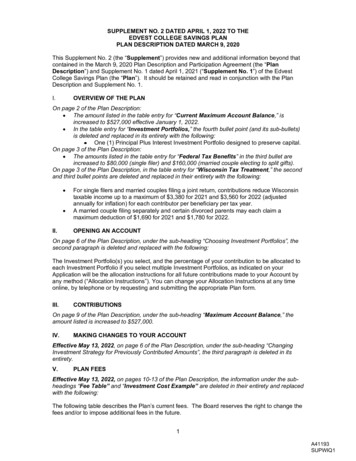
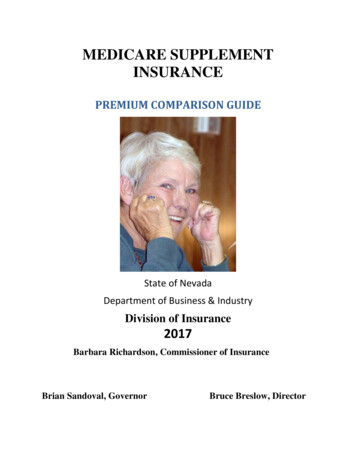
![WELCOME [ montclair.edu]](/img/31/commencement-program-2022.jpg)
